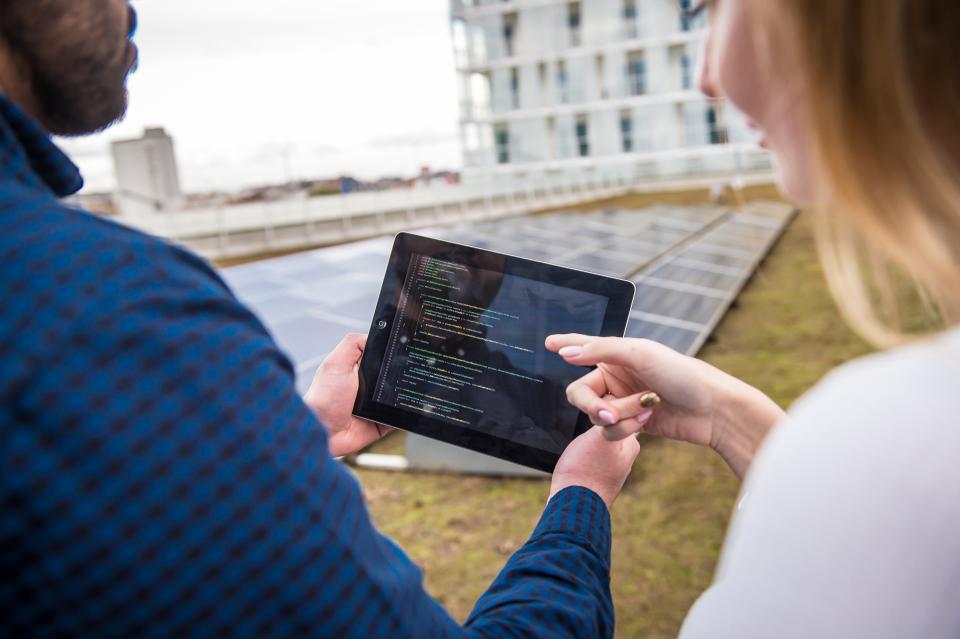INTRODUCTION
Within a Local Energy Community (LEC), two or more digital meters of LEC members can be offset against each other to form a single net consumption. This is an administrative procedure: one kilowatt-hour generated but not consumed at location X can be represented by one token. By transferring these tokens to another member within the LEC (member Y), Y's meter reading can be reduced by 1 kilowatt hour. It is therefore not about the physical exchange of energy, but about the exchange of representations (tokens) of energy in an administrative process.
The legal and administrative framework around setting up and managing a Local Energy Community is taking shape, but has not yet been finalised. In our project, we will therefore look at how to efficiently, smartly and securely run the (virtual) exchange of energy in an energy community. Within these communities, members' digital meters can be balanced with each other, for instance if a member sells a surplus of green energy to another member. The research group is testing a blockchain application to facilitate this transaction with smart contracts. Thus, surplus energy can be exchanged decentrally, peer-to-peer.
In 2023, we developed a virtual proof-of-concept of this system. The proof-of-concept shows that we can read a digital meter and publish the data on the blockchain. In 2024, we will develop this further and test how performant and robust this system is compared to other systems. We take a broad interpretation of 'performant' to include, for example, the sustainability of the system itself. For us, robustness is the error rate of the system and the operational stability of the solution. We carry out our test cases in a strong partnership with the city of Sint-Niklaas. The research team is strongly involved in the start-up and management of the LEC and will use this case to draw up a roadmap for the start-up of an LEC on the one hand and to be able to test the administrative application on the other.
In the next phase, we will then benchmark our application and roadmap with other cases. These local energy communities often work with a different administrative application and can be used to test the relevance of our roadmap. With each partner, we test the performance of our administration system against the system used by the new partner. In doing so, our hypothesis is that our blockchain system will be more performant and robust in at least some contexts.
RESEARCH QUESTIONS
- What criteria determine the success of a transaction system for a local energy community?
- To what extent does our blockchain-based transaction system meet these criteria?
- How do competing energy community transaction systems score on these criteria?
- Under what conditions - if any - is the deployment of a blockchain-based transaction system desirable over another system?
- What are the criteria for a successful start-up of a Local Energy Community?
RESEARCH METHOD (Based on Design science research)
For question 1, based on literature review and stakeholder interviews, we arrive at a list of criteria that a good transaction system for an energy community should meet. With this, we create a scorecard for the successful functioning of transaction systems in a local energy community.
For questions 2 to 4, we initially work with the case study of the city of Sint-Niklaas to arrive at a tested prototype. In a second phase, we test our system with other case studies to refine and improve it. Here, we run our transaction system in parallel with the chosen transaction system of the test case. During this process, we score performance and robustness of our system (question 2), and that of the competing system (question 3). We do so based on the criteria and scorecard that are the outcome of research question 1. Finally, based on the answers to questions 2 and 3, we try to draw conclusions about the specific circumstances in which deployment of our system is or is not desirable.
For question 5, we will prepare a roadmap based on literature reviews around legal requirements and the experiences from the first case study. This roadmap will then also be tested in a second phase with the other case studies to increase its applicability and relevance.
PLANNED RESULTS
What strive for the following results:
- Elaborated prototype, in which we settle multiple digital meters with each other (pilot setup with 5 meters).
- Scoring map for the performance and robustness of transaction systems in energy communities.
- Reporting on the performance and robustness of our system against competing systems.
- Roadmap for setting up local energy community systems.
- Roadmap for setting up local energy communities.






